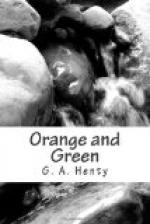They stood the charge unbroken, but again and again the Irish horse charged down upon them, with the greatest gallantry. William pushed two regiments of French Huguenots and one of British across the river, to the assistance of the Dutch guards, and ordered Sir John Hanmars and the Count of Nassau’s regiment to cross, lower down the stream, to support them.
As the supports were making a passage, General Hamilton advanced, at the head of a body of Irish infantry, to the water’s edge, and, dashing into the river, encountered the French Huguenot regiments in the middle of the stream. A desperate fight ensued, but the French made their way across, and Hamilton, falling back with his infantry, opened to the right and left, permitting the Irish horse to charge through them.
These rushed with fury upon the French regiment of Colonel La Callimot, and cut their way right through them. Then, wheeling, they charged them in flank again, broke them, and drove them into the river. La Callimot himself was killed, and but few of his regiment regained the opposite bank.
In the meantime the Dutch guards, now reinforced, were advancing slowly, the Irish infantry holding fast to the hedges and brushwood, and contesting every inch of the ground, while, wherever the ground permitted it, the Irish horse burst down upon them, evincing a gallantry and determination which would have done honour to the finest cavalry in Europe. The king continued to make repeated efforts to support his Dutch troops, and, after the French were broken, he pushed forward the Danish horse; but no sooner had they crossed the bank than the Irish cavalry burst down upon them, broke them, and drove them back into the river. They fled across the stream in disorder, and dispersed in all directions.
So far, success had rested principally with the Irish; the Dutch guards alone remained unbroken in the centre; the French infantry and Danish horse were broken and destroyed. Old Duke Schomberg exerted himself to the utmost, to restore the battle at this point, and, having rallied the French infantry advanced with them, and a few French cavalry, towards the river, where he was met by some of the Irish horse returning from the pursuit of the Danes. The old duke was cut down and his party again routed, and at the same moment Walker, the clerical commander of Derry, received a mortal wound.
After his successful defence of Derry, this man had gone to London, where he had been feted and made much of, and had then attached himself to King William’s army, where he posed as a high military authority, although much discouraged by the king, whom his arrogance and airs of authority displeased.
While in the centre William’s forces were getting worsted, and on his right Douglas and Count Schomberg were inactive and powerless, he himself was leading his left wing across the river. The passage was a difficult one, and the king himself was only extricated, with much exertion, from a quicksand into which his horse had plunged.




